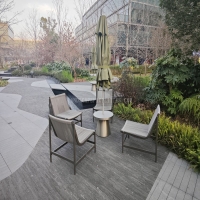Welcome to the website for landscape facilities products and knowledge.
How do landscape tables address concerns about surface slipperiness when wet?
Landscape tables are a popular choice for outdoor spaces, but concerns about slipperiness when wet often arise. To address this, manufacturers employ several innovative design and material solutions.
1. Textured Surfaces: Many landscape tables feature textured tops, created through patterns or grooves that increase traction even when water is present. This micro-texturing disrupts the smooth surface that causes slips.
2. Non-Slip Coatings: Specialized coatings, such as polyurethane with added grit or rubberized finishes, are applied to table surfaces. These coatings maintain their grip properties in rainy conditions.
3. Material Selection: Porcelain, concrete, and certain composites used in high-quality landscape tables naturally offer better slip resistance than smooth materials like untreated wood or metal.
4. Drainage Design: Some tables incorporate subtle slopes or perforations that allow water to run off quickly rather than pooling on the surface.
5. Maintenance Features: UV-resistant and mold-inhibiting treatments prevent the growth of slippery algae or moss that can develop on constantly wet surfaces.
By combining these approaches, modern landscape tables achieve ANSI/BIFMA safety standards for slip resistance while maintaining aesthetic appeal. Proper installation on level ground further enhances their safety performance in wet conditions.
Related search:

Recommendation
Metal structure rattan chair without armrests for single person, with woven seat and backrest.